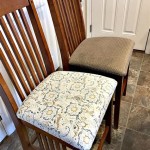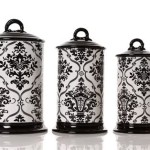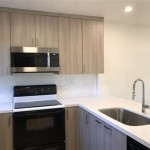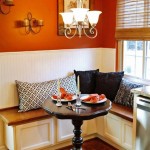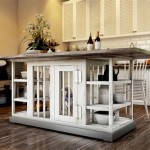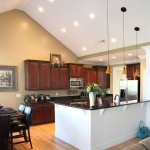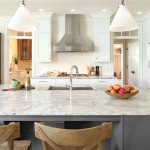Recessed Lighting For Kitchen Ceiling: A Comprehensive Guide
Recessed lighting, also known as can lights or pot lights, has become a staple in modern kitchen design. Its popularity stems from its ability to provide efficient and discreet illumination, maximizing space and creating a clean, contemporary aesthetic. Choosing the right recessed lighting for a kitchen ceiling involves careful consideration of various factors, including the size of the kitchen, the existing infrastructure, the desired light output, and the specific tasks performed within the space. This article provides a comprehensive guide to understanding and selecting recessed lighting for kitchen ceilings.
Understanding the Benefits of Recessed Lighting
Recessed lighting offers several advantages over traditional lighting fixtures, making it an attractive option for kitchen environments. One of the primary benefits is its space-saving design. Because the fixtures are installed flush with the ceiling, they do not obstruct headroom or visually clutter the space. This is particularly important in smaller kitchens where every inch counts. Furthermore, recessed lighting contributes to a streamlined and minimalist aesthetic, complementing a wide range of kitchen styles, from modern and contemporary to transitional and even some traditional designs.
Another significant advantage is the versatility of recessed lighting. It can be used for general ambient lighting, task lighting, and accent lighting. By strategically positioning recessed lights, homeowners can create a layered lighting scheme that caters to different activities within the kitchen. For instance, brighter, more focused lights can be installed above work surfaces like countertops and islands, while softer, more diffused lights can be used to illuminate dining areas or create a relaxing atmosphere. This flexibility allows for a highly customized lighting solution tailored to the specific needs of the kitchen.
Finally, recessed lighting can be energy-efficient, especially when combined with LED (light-emitting diode) bulbs. LEDs consume significantly less energy than traditional incandescent or halogen bulbs, resulting in lower electricity bills and a reduced environmental impact. LED recessed lights also have a longer lifespan, minimizing the need for frequent replacements. This combination of energy efficiency and longevity makes recessed lighting a cost-effective and sustainable lighting option for the kitchen.
Key Considerations for Choosing Recessed Lighting
Selecting the right recessed lighting for a kitchen ceiling requires careful planning and consideration of several key factors. This includes determining the appropriate size and type of fixture, understanding the spacing and placement guidelines, and choosing the right type of bulb.
1. Fixture Size and Type: Recessed lighting fixtures come in various sizes, typically ranging from 3 to 6 inches in diameter. The size of the fixture should be chosen based on the overall size of the kitchen and the desired light output. Smaller kitchens generally benefit from smaller fixtures, while larger kitchens may require larger fixtures to provide adequate illumination. The most common types of recessed lighting fixtures include standard recessed cans and remodel recessed cans. Standard recessed cans are designed for new construction and require access to the ceiling joists, while remodel recessed cans are designed for existing ceilings and can be installed without major structural modifications. The trim, which is the visible part of the fixture that sits flush with the ceiling, also comes in various styles, including baffle, reflector, and adjustable trims. Baffle trims reduce glare, reflector trims maximize light output, and adjustable trims allow for directing light to specific areas.
2. Spacing and Placement: Proper spacing and placement are crucial for achieving optimal illumination and avoiding uneven or glaring light. A general guideline is to space recessed lights apart by half the ceiling height. For example, in an 8-foot ceiling, the lights should be spaced approximately 4 feet apart. The distance from the wall should also be considered, typically ranging from 2 to 3 feet. Specific task areas, such as countertops, islands, and sinks, should be directly illuminated with recessed lights to ensure adequate visibility. It is also important to avoid placing recessed lights too close to cabinets or appliances, as this can create shadows and uneven lighting. Professional lighting designers can provide detailed lighting plans that take into account the specific dimensions and layout of the kitchen.
3. Bulb Selection: The choice of bulb is a critical factor in determining the overall quality and efficiency of the recessed lighting system. LED bulbs are generally recommended for their energy efficiency, long lifespan, and versatility. They are available in a wide range of color temperatures, measured in Kelvin (K), which determines the warmth or coolness of the light. Warmer color temperatures (2700K-3000K) create a cozy and inviting atmosphere, while cooler color temperatures (4000K-5000K) provide a brighter and more energetic light. For kitchens, a color temperature of 3000K-4000K is generally recommended, as it provides a balanced and natural light. The brightness of the bulb is measured in lumens, with higher lumens indicating a brighter light. The required lumen output will depend on the size of the kitchen and the desired level of illumination. Dimmable LED bulbs offer additional flexibility, allowing homeowners to adjust the brightness of the lights to suit different activities and moods.
Installation Considerations and Safety Precautions
Installing recessed lighting involves working with electrical wiring, so it is essential to prioritize safety and follow all applicable building codes. If you are not comfortable working with electricity, it is highly recommended to hire a qualified electrician to perform the installation. Even for those with electrical experience, consulting with a professional is advisable to ensure compliance with local regulations and to avoid potential hazards.
Before starting the installation, turn off the power to the circuit that will be used for the recessed lighting. Use a voltage tester to verify that the circuit is de-energized. Carefully plan the layout of the recessed lights, marking the locations on the ceiling and ensuring that there are no obstructions, such as plumbing pipes or electrical wires. Use a hole saw to cut the appropriate-sized holes for the recessed cans. Connect the electrical wiring to the recessed cans, following the manufacturer's instructions and using appropriate wire connectors. Secure the recessed cans to the ceiling joists or to the existing ceiling structure. Install the trim and bulb, and then turn the power back on to the circuit to test the lights.
When choosing recessed lighting fixtures, ensure that they are IC-rated (insulation contact rated). IC-rated fixtures are designed to be safely installed in contact with insulation, which is important for preventing overheating and reducing the risk of fire. Non-IC-rated fixtures require a minimum clearance from insulation, which can be difficult to achieve in some kitchens. Also, when working in older homes, asbestos can be a concern. If the home was built before 1980, always have the ceiling and any insulation tested before disturbing it. If asbestos is present, a professional abatement company should make the alterations required before installing the lights.
Proper ventilation is another important consideration. While LED bulbs produce less heat than incandescent or halogen bulbs, it is still essential to ensure adequate ventilation to prevent overheating. Choose recessed cans that are designed to allow for proper airflow and avoid overcrowding the ceiling with too many fixtures. Regular maintenance of recessed lighting fixtures is also important. Periodically check the bulbs and replace them as needed. Clean the trim to remove dust and debris, which can reduce light output. Inspect the wiring connections to ensure that they are secure and free from corrosion.
Ultimately, selecting and installing recessed lighting for a kitchen ceiling is a multifaceted process that requires careful planning, attention to detail, and a commitment to safety. By understanding the benefits of recessed lighting, considering the key factors involved in fixture selection and placement, and following proper installation procedures, homeowners can create a well-lit and aesthetically pleasing kitchen environment.

Recessed Lighting Buying Guide The Home

How Much Does It Cost To Install Recessed Lighting In 2024

How To Update Old Kitchen Lights Recessedlighting Com

Open Up Your Kitchen With Recessed Lighting Lightstyle Of Tampa Bay

Recessed Lighting Luzes De Teto Para Cozinha Iluminação Embutida No Luz

Recessed Lighting Buying Guide Lowe S

Designer Overhead Kitchen Light Fixtures Lahome Com Lighting Remodel Ceiling Lights Recessed

What Is Recessed Lighting Flip The Switch

8 Pack Led Recessed Lighting 4 Inch Ceiling Lights With Junction Box 5 100 Dimmable Etl Certified 2700k Soft White Walmart Com

Learn How Recessed Lighting Can Transform Your Kitchen

